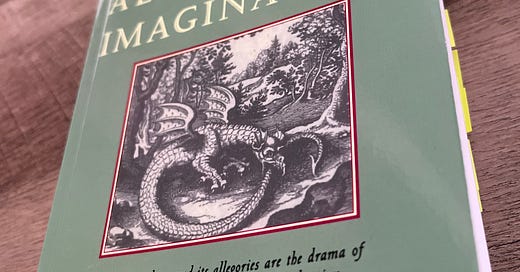Review: Jung and the Alchemical Imagination by Jeffrey Raff
Jung and the Alchemical Imagination is an elaboration and description of Carl Jung’s investigation of alchemy. For Jung, alchemy was the projection of unconscious contents onto the material world. By manipulating material objects, we, coincidentally, caused chemical reactions – and discovered chemistry as a science. More often, we manipulated objects to little chemical effect – yet the work persisted. Why? Why did alchemists play with matter for thousands of years without effect? Because the practice was an art-form wherein the manipulation of objects, plastered with the projections of the unconscious, resulted in the manipulation and ordering of the unconscious mind. Effectively, it was a spiritual/psychological practice akin to meditation or art therapy.
Jung, in his characteristically wandering language, describes the process of this work (the magnum opus). Raff elaborates on this process. As an introduction to Jung’s ideas, this book is incredibly useful. It simplifies Jung’s complex language and describes plainly the psychological intervention known as “active imagination,” wherein one interacts with the characters in one’s imagination thereby discovering and integrating parts of oneself.
However, he makes a fatal error. By conflating the symbol of the Great Father, the king-image and archetype (e.g., King Arthur, Denethor, Aragorn, The Patriarchy, etc.), with the archetype of the Self (e.g., Christ, Buddha, the Anthropos, etc.) he comes to increasingly weird conclusions. In other words, by confusing the spirit of culture with the spirit that transcends culture he must posit an extra dimension of transcendence.
This dimension is the “psychoid” realm. In some passages Raff says psychoidal characters “feel” like they come from outside the psyche. In other passages he says they “do not originate in the psyche.” On one hand, Raff’s psychoidal characters are a phenomenological description; “I experience these characters as ‘external’ agents.” On the other, he suggests they are external agents with equivalent (or more) reality as you or I. He is unclear about this and can be forgiven, insofar as he does not have evidence one way or the other, but he frequently drifts towards the later explanation. Ultimately, he alludes to an external ‘dimension’ populated with spirit entities who originate outside of the psychological domain. Color me skeptical.
He makes this mistake for good reason. For many centuries a king was ‘the highest’ among us, the most powerful and therefore a decent representative of the God-image. Thus, we had “God-Kings.” However, a subtler interpretation is that the “rightful king” was one who best incarnated the God-image and therefore, for a time, the Self and the King were con-fused. Only later did we differentiate the King and the ideal the King aspired to. In differentiating them, we recognized a “King of Kings” and “Lord of Lords” – this was an ideal/pattern/image/archetype which transcended and subordinated literal kingship. This transcendent image is represented by the archetype of the Self. Tragically, Raff conflates these two archetypes.
As such, Raff believes that the classic image of the King (i.e., the Self for Raff) and the Queen (i.e., nature and the unconscious) in matrimony is the marriage of the manifest Self and one’s unconscious. The Son born from this marriage is therefore a ‘higher Self,’ or transcendent Self. Thus, he needs a place to put this new self; the Psychoid realm. In reality, the King is a representative of culture and those products of culture we understand (i.e., conscious of). This makes the hieros gamos a marriage between culture/consciousness and nature/unconsciousness giving birth to a newly born Self. In other words, the Son born of the King is not some psychoidal-Self but a representation of the heroic individual who has transcended nature and culture to revivify the world.
All in all, it was a helpful but flawed book. Raff usefully differentiates between a “latent Self” (i.e., the potential Self) and Manifest self. This makes concepts like the prima materia far more comprehensible, but his confusions lead the reader astray. Had he left the psychoid within the psyche, we would be better off. It may be worth reading to clarify Jung, but the “psychoid” realm is unjustified and unclear.




